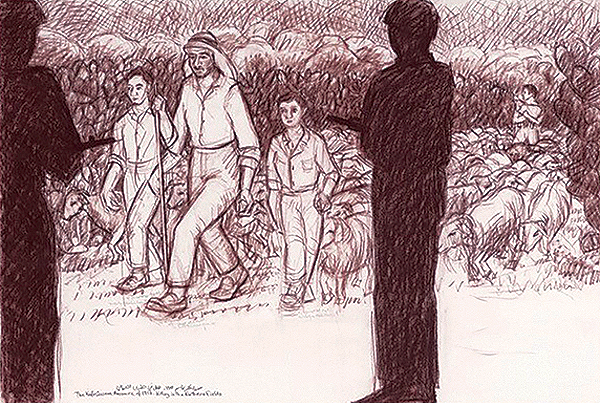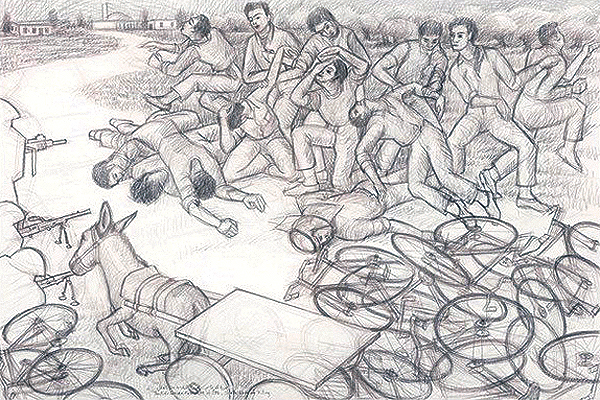By: Samia Halaby
Birzeit University Museum
February 22 to May 30, 2017
……………………………………………………………………
By: Inass Yassin
Birzeit University Museum is launching a unique exhibition of drawings by Samia Halaby. An artist internationally acclaimed for her rich contribution to the art scene, she has left a distinctive mark on contemporary abstract painting and considers her work to be an extension of liberation art.
For more than six decades, Halaby has explored and emulated new trends of various modern art schools, believing that painting is a key element of visual culture. At one point, her art production even crossed over into digital painting technology.

Halaby’s series “Documenting the Kafr Qasem Massacre in Painting” that puts on display 16 prints as reproductions of her drawings, however, presents a different side of her work. Halaby is also an activist and advocate for the Palestinian cause and uses illustrations and detailed scenes to document a painful and largely undocumented historical event – the Kafr Qasem Massacre. She researched the project for years, frequently visiting survivors, and based her work on stories they told, their accounts of the relatives they lost in the massacre – in many cases entire families – and all the press materials she could find.
Interestingly, Halaby presents the paintings as a work of documentation rather than a work of art. She leads us to recognize the strong bond between her art production and her political activism that often pushed her to explore Palestinian art as liberation art. In creating the series, the artist relied on the narrative pattern previously used by Emile Habibi in his book, On the 20th Anniversary of the Kafr Qasem Massacre: Kafr Qasem, the Political Massacre, now rare and difficult to find. For Halaby, this project falls within the framework of her activism, much like her design work of posters and banners that have been used in demonstrations across the United States. Through this project, she manages to raise questions on the role and place of art in life.
Samia Halaby’s exceptional art experience makes her a main reference for the study of modern and contemporary painting practice and bears witness to a unique model of art activism, whereby an artist-advocate’s political devotion to a cause never compromised the quality and quantity of the world-class art she has produced over the years.

This series is to form a permanent part of the Birzeit University Museum collection and be forever present in the consciousness of future generations. Halaby has already made a number of contributions to the Birzeit Museum’s collection, donating a number of her works and helping collect artwork by other artists. Furthermore, she has visited the university several times and met with students in art workshops. Whereas she has previously participated in group exhibitions, this is Halaby’s first solo show at the Birzeit Museum that will also present three recently completed acrylic paintings as well as her book, Drawing the Kafr Qasem Massacre. The book focuses on the drawings presented in the exhibition and on the work the artist has conducted with the people of Kafr Qasem, to whom she, and we at Birzeit University, extend our deepest thanks and gratitude.
Born in Jerusalem in 1936, Samia Halaby is a not only a leading abstract painter but also an influential scholar of Palestinian art. Although based in the United States since 1951, Halaby is recognized as a pioneer of contemporary abstraction in the Arab world. Influenced by the abstract movements of the Russian avant-garde, she works with the conviction that new approaches to painting can redirect ways of seeing and thinking not only within the realm of aesthetics but also as contributions to technological and social advancement. Since the 1970s, her work has been collected by international institutions, including the Solomon R. Guggenheim Museum of Art (New York and Abu Dhabi); Yale University Art Gallery; National Gallery of Art, Washington D.C.; Art Institute of Chicago; Cleveland Museum of Art; Institut du Monde Arabe; and the British Museum. Samia Halaby is represented by Ayyam Gallery (Beirut/Dubai).

